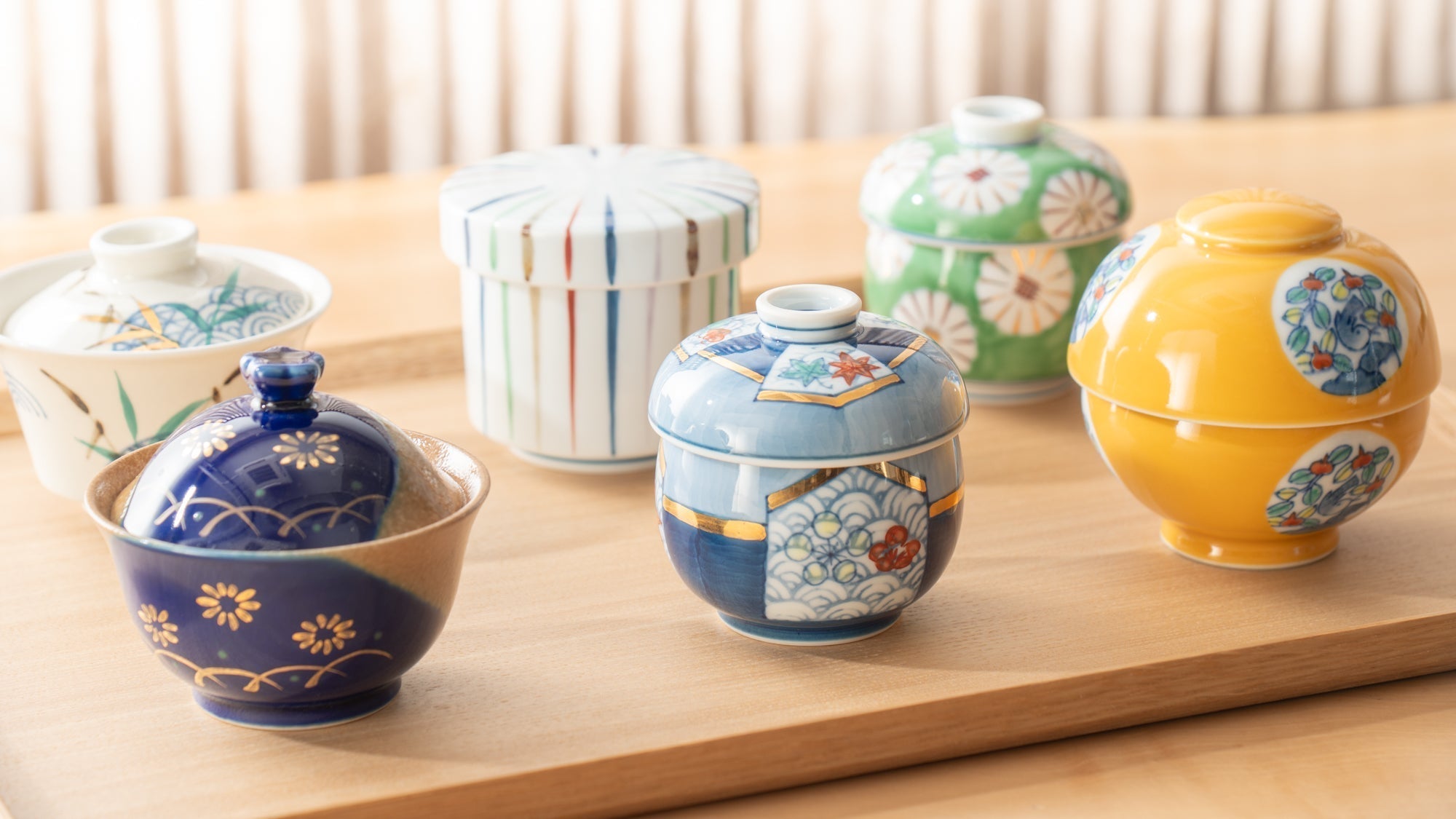
The Crafting Secrets of Chawanmushi Bowls
Written by Team MUSUBI
This time, we are introducing chawanmushi bowls by Tasei Kiln, renowned for its exquisite craftsmanship, produces chawanmushi bowls that not only enhance the presentation of the dish but also elevate the dining experience.
Join us as we explore the beauty and functionality of chawanmushi bowls and discover how these pieces can bring a touch of Japanese tradition to your dining table.
Table of Contents
Expert in Making Chawanmushi Cups: Tasei Kiln

Preparing chawanmushi involves steaming a seasoned egg mixure and other ingredients, a process that requires a well-sealed container to prevent steam from escaping. Crafting such a container that ensures a perfect seal while maintaining aesthetic beauty is no simple task.

Tasei Kiln, located in Arita Town, Saga Prefecture, was founded in 1956 with a focus on creating chawanmushi cups. Few kilns dared to tackle the challenge of ensuring that the lid and body of the cup fit tightly enough to prevent steam from escaping, but Tasei Kiln took on this challenge head-on, developing a wide variety of designs. To date, they have created over 100 different shapes.

What is Chawanmushi?

Chawanmushi is a delightful Japanese dish that captivates both the eyes and the palate. What makes chawanmushi unique is its silky texture, achieved by steaming a mixture of beaten eggs, dashi “Japanese soup stock,” and soy sauce. The dish often includes ingredients like shrimp, chicken, shiitake mushrooms and ginkgo nuts, which add layers of flavor and surprise in every bite.
Served in a beautifully crafted chawanmushi cup, it is not only a treat to eat but also a visual delight, embodying the elegance and precision of Japanese culinary arts. If you’re interested in the detailed preparation method, be sure to check out Chawanmushi Recipe: Your Guide to Ultimate Comfort.
Chawanmushi Cups for MUSUBI KILN
The chawanmushi cups for MUSUBI KILN are designed for functionality and ease of use. The colors and patterns are inspired by the natural beauty and traditional motifs of Japan, allowing users to experience the emotional connection to the changing seasons inherent in Japanese culture. Tasei Kiln has successfully developed these top-quality chawanmushi cups, a feat only they could achieve.
Let's take a closer look at the charm of six unique chawanmushi cups.

This chawanmushi cup, primarily colored in elegant blue and soft brown, and decorated with golden chrysanthemums, was designed by the Head of Tasei Kiln, Tanaka Ryota. The striking contrast in colors catches the eye. The bowl is partially dipped in a blue pigment to achieve a smooth and draping coat, creating gentle and natural curves on the surface.
The design features a lid that fits inside the rim of the cup, giving it a cute appearance and making it also perfect for serving desserts.

This white chawanmushi cup showcases the traditional Japanese seigaiha "wave" pattern and botanical designs, exuding a sense of refined elegance. The seigaiha pattern symbolizes good fortune, with its expanding ripples representing the growth of positive relationships.
A closer look reveals two types of wave patterns: one with clear brushstrokes and the other with fine white dots embedded in the blue. This meticulous design aims to convey the dynamic movement of waves from afar to near, enhancing the user's sense of the ocean's presence.

This green chawanmushi cup, with its rounded shape and classic design, is adorned with golden chrysanthemums, beautifully conveying the feeling of autumn.
The chrysanthemums are first painted and fired to ensure that the green glaze does not interfere with the flower design. Craftsmen then carefully fill in the green background, stroke by stroke, around the flowers. This method results in a nice uniform and striking pattern.

The verticle patterns in various colors of this cylindrical chawanmushi cup dates back around forty years. Known as mugiwarade, it represents abstract depictions of wheat and evokes an autumnal atmosphere. In Japanese culture, the upright appearance of wheat symbolizes good fortune. Creating this pattern requires the craftsmen to have precise control over their brushwork to produce smooth and dynamic lines.
The simple design of this chawanmushi cup offers a generous capacity, making it versatile for various uses.

This charming chawanmushi bowl features a warm yellow color, with sophisticated designs that make it both cute and interesting. The round form is particularly eye-catching.
After painting the intricate patterns within the white circular areas, craftsmen apply a waterproof coating to fix and protect the design. Then, they apply the yellow glaze, creating a window-like effect that enhances its traditional aesthetic appeal.

This chawanmushi cup is adorned with the seigaiha pattern and seasonal plants like plum blossoms and maple leaves. The production process involves first painting the detailed patterns and firing the piece. Afterward, artisans carefully fill in the design, line by line. Bold gold lines embellish the cup, which enhances its overall appearance with a touch of luxury.
We hope you enjoyed exploring the exquisite chawanmushi bowls crafted by Tasei Kiln. These unique pieces, exclusive to MUSUBI KILN, perfectly blend tradition and modernity. Each, with a distinct personality, boasts high functionality and excellent heat retention. Bring a touch of Japanese culture and sophistication to your table with these beautiful chawanmushi bowls.







Leave a comment
This site is protected by hCaptcha and the hCaptcha Privacy Policy and Terms of Service apply.